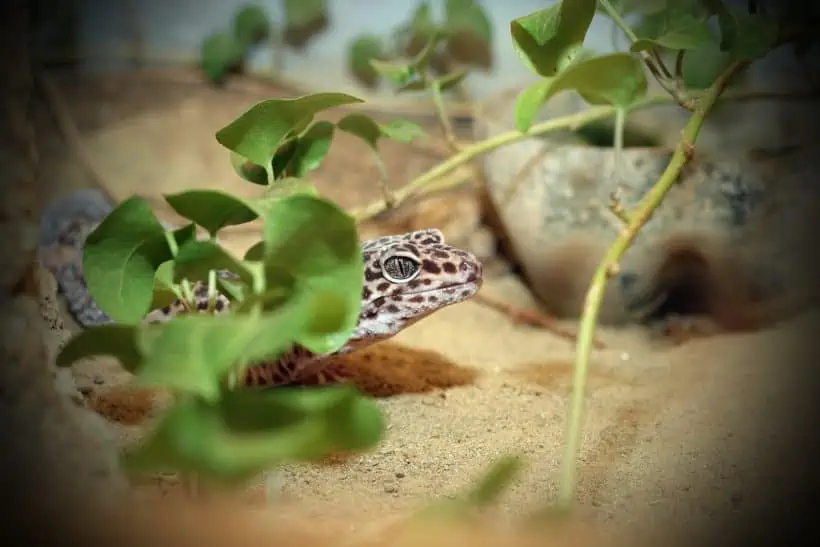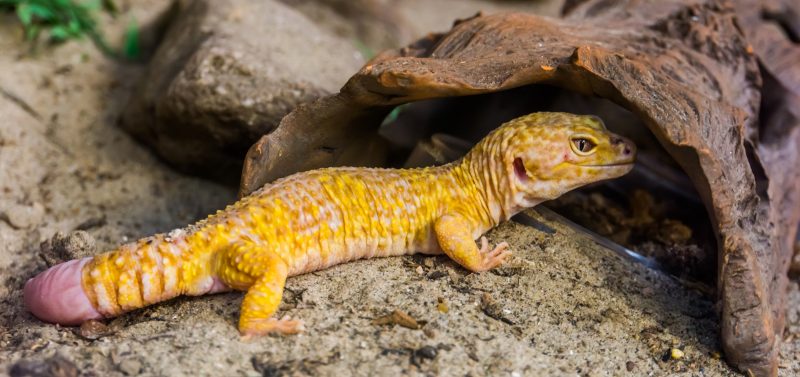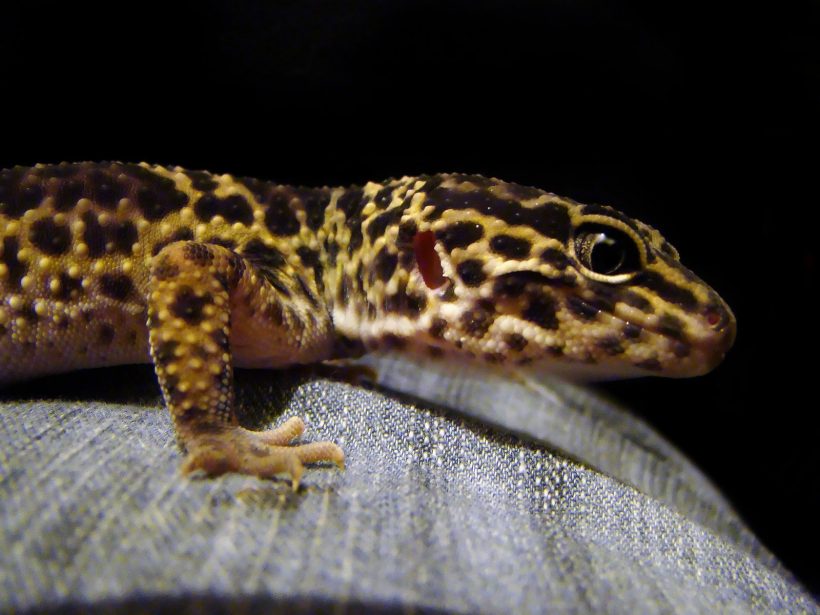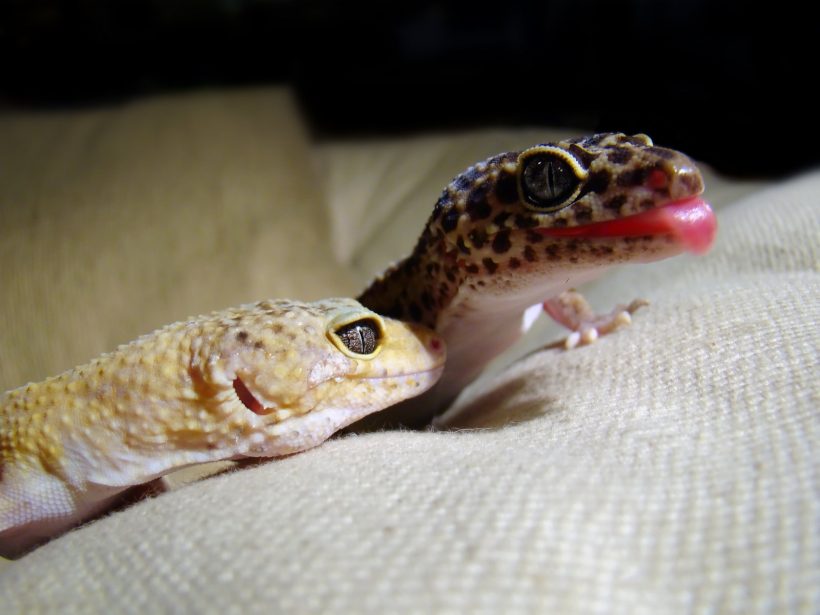We all love our beautiful pets and want them to live.
Ideally – forever.
Realistically – for as long as possible.
Besides warm emotions and attention, truly loving our pets means constant care for their wellbeing – and a long-haul effort to keep death at bay.
Recognizing signs of health decline and taking immediate therapeutic action are the primary ways to prevent premature death in any animal – including a leopard gecko.
However, no matter how good you are at it, you can’t fool nature. Everything born on this planet has to die so the matter and energy could be “reborn”. Life on Earth depends on this cycle. That is why there is a saying, “Every beginning has an end – and every end has a new beginning.”
We all want to know if the end is near, so we can be ready for the moment of passing of our beloved pet when it comes.
Have you ever wondered:
- What are signs of an unhealthy leopard gecko?
- What does a dying leopard gecko look like?
- How can I help my dying gecko?
If you have asked yourself these questions – and most of us have – please read on.
With this article, I’m hoping to do the following:
- Empower you with knowledge and help you spot the signs of health emergency in leopard geckos – and how to turn the tide.
- Help you get ready for the passing of an elderly pet leo, and explain what you can do to make him feel cozy and safe.
I will cover the primary signs of illness and stress that could put a leo at risk of early death. Also, I’ll try to give sound advice on how to help a leo that is inevitably nearing the end.
Signs of an Unhealthy Leopard Gecko
Now, let’s have a look at the major red flags, signaling that something may be wrong with your leo and that his life may be in danger.
Lack of Appetite and Anorexia
Leopard geckos naturally have hearty appetites – up to the point that their owners sometimes manage to overfeed them. While a healthy leo will rarely decline to have a bite, a sick gecko will nearly always do so. The lack of appetite taken to the extreme is called anorexia.
A leo that is not eating will also not poop. The lack of feces in the leo’s tank signalizes that he is not taking in anything – or could be a sign of critical bowel blockage called impaction even if he does eat from time to time.
Why My Leopard Gecko Won’t Eat?
As food refusal is one of the starkest signs that something is not right with your leo, it would be great if its interpretation would be straightforward.
Unfortunately, it’s not.
Leos can stop eating and pooping for many reasons. Here are the main ones, from the most common to the rarer ones.
- Impaction
- Metabolic bone disease (MBD) – usually in the late stages.
- Severe parasitic infection
- Egg binding (in females)
- Injury of the digestive system (e.g., by food that is too large or bites on its way down the leo’s throat)
- Mouth rot
- Organ failure
- Cancer or another type of tumor pressing on the digestive system
Other non-critical reasons why your leopard gecko won’t eat:
- Brumation
- Cold tank
- Stress from cohabitation,
- Too much lighting
- Ovulation in females.
As you see, sometimes the behavioral changes that look like a deadly condition can simply be a regular part of your leo’s yearly life cycle.
Still confused? Here’s an example.
Lack of appetite and food refusal can be a sign that your leo’s life may be hanging by a thread. However, if it’s autumn or winter and the temperature in the tank is lower, your pet may be entering brumation. If your gecko is a girl and it’s late springtime or summertime, she may be ovulating – carrying an egg (regardless of whether she has a mate around or not) which can cause her to stop eating.
What Can I Do?
- Check the temperature and lighting in your tank. Stress from low temperatures or harsh lighting could cause your leo to stop eating.
- Try a carnivorous reptile formula to stimulate appetite and get some nutrients into your starving leo’s system; sometimes, that is enough to get them going again if the process behind their lack of appetite is not severe. Alternatively, you can make the formula yourself if a professional product is not available to you.
- Give your leo a lukewarm bath – it could make the lighter cases of impaction go away.
- If the ordeal continues, make sure to contact your reptile vet immediately. Impaction is one of the leading causes of death in leopard geckos, and you cannot solve severe it without veterinary assistance.
Thin Tail and Skinny Look
A healthy leo should have a fat tail and no ribs or spine outlines visible below the skin. When losing weight, leos first lose their tail fat and other fatty deposits, and then some muscle mass. Losing weight is often associated with anorexia, in which case all the advice from anorexia sections apply.
What Can I Do?
- Have a digital kitchen scale at hand and measure your leo’s weight at least once per month. Make a chart and write down the values so you can track how he’s doing.
- In the case your leo is eating but keeps on losing weight, parasite infection is highly likely. A reptile vet should test his stool for parasites and prescribe therapy.
- Tumors can also cause weight loss. Again, call your vet if you’re noticing any changes in body shape or see strange structures inside the leo’s belly when looking at it.
Wounds, Abscesses, Changes in Body Shape
Superficial injuries in leopard geckos can be caused by inadequate decoration in the tank, aggressive prey items (e.g., crickets), or attacks by tankmates (which is why we never recommend cohabitation). Also, heaters and lights can cause severe burns. The untreated wounds can lead to fatal infections.
Fortunately, today there are specialized products for immediate disinfection of wounds in reptiles. Also, you can use some general antiseptics and antibiotic ointments (but with caution!).
Unlike wounds that can be treated at home (provided they are not extensive), abscesses and tumors must receive veterinary attention. Sometimes, a tumor or another dangerous problem with internal organs will manifest itself as a change in body shape, such as a swollen belly. These unusual changes should be checked out by a reptile vet as soon as possible.
Can Leopard Geckos Die of Stress?
While leopard geckos are tough little creatures in general, there is a definite connection between stress and premature death in leos.
Stress in pet reptiles occurs due to inadequate keeping conditions, injury, or illness. In time, the wrong conditions will inevitably lead to health disorders and sickness that can ultimately result in death.
That is why good keeping and handling practices are essential to ensure a long and happy life of a pet leopard gecko.
What Are Signs of Stress in a Leopard Gecko?
The most common signs of stress in leopard geckos are the following:
- Stress licking
- Tail waving
- Tail drop
- Vocalizing
- Excessive hiding
- Closed eyes
- Gaping mouth
- Glass surfing
To learn how these signs look in more detail and what you can do about them, please read our article on stress in leopard geckos.
It is important to note that pain in leopard geckos is usually manifested with stress signs as well.
Can a Leopard Gecko Be Scared to Death?
Leopard geckos are quite tough in general. Although we cannot know for sure, reptiles lack the limbic brain in charge of emotional responses like fear and anxiety. Thus, they most likely don’t experience “fear” as we do. Unlike other small mammalian pets such as hamsters and guinea pigs, leos cannot be directly startled to death by a loud noise, sudden movement, or physical contact.
However, long-term stress can cause harm to leo’s overall wellbeing. It will inevitably lead to a health decline that can end fatally if not stopped in time. That stress can include repeated exposure to situations that could bring up fear in mammals.
For example, a leo that inhabits a room with a loud sound system, who is constantly roughly handled, or often gets attacked by other pets will do poorly and have a shortened lifespan. That is true even if these events do not directly hurt him.
Leopard Gecko Female Lifespan – Breeding Leos, Stress, and Death
With proper care, pet leopard geckos can reach the age of 20 – or more.
However, many available resources will tell you that the lifespan of a female leo is much shorter than that of a male. The life expectancy is cited to be 6-10 years for a female and 15-20 for a male leo.
Is there any truth to these claims? Do male leos live twice as long as females?
The harsh difference in lifespans is thought to be due to the reproductive burden – because a body needs a lot of energy and nutrients to form eggs. A breeding leo female can lay a clutch every 15 to 22 days over five months each year – which translates to 80 to 100 eggs over a lifetime.
Considering all of the above, it is likely that a female who is bred each season will have a shorter life than her non-breeding female counterpart.
However, the fact is that leopard gecko care has evolved significantly in the past two decades or so. Today, even the breeding females have a chance of reaching older age than in the early days of leopard gecko husbandry.
Still, creating eggs will inevitably take its toll. Even if you provide the female leo with the best nutrition, that can’t entirely prevent deadly complications such as egg binding.
In short, if you are not a breeder and want to ensure a long life for your pet leo girl – simply opt not to breed. I can offer anecdotal evidence to back this up. My two leo females, who have never been bred and have the care I would describe as good or average, are currently 21 and 20 years old – and going strong.
What Can I Do if My Leo Is Really Dying?
In some cases, the disease will take its course no matter what we do. With old individuals in a state of decline, a vet will conclude that they are healthy but reaching the end of their lifetimes.
If your leo shows signs of fading away – which can be manifested by any of the signs I described so far – the only thing you can do is make him as comfortable as possible.
Here are a couple of suggestions on how to make a dying gecko feel taken care of.
- First of all, don’t abstain from consulting a veterinarian specializing in exotic pets.
- Make sure that the temperature in the tank is optimal.
- Make sure that the lights aren’t overly bright; dim if possible.
- If your leo is losing a lot of weight, try feeding him waxworms and extra-nutritious food items.
- If your leo doesn’t want to be bothered, respect that – especially if he seems to be in pain (and see below).
- If your gecko doesn’t seem to be in pain or bothered by handling, feel free to hold him gently. The warmth of your hands will feel pleasant to him, and you will get a precious chance to spend a bit more time with your reptile friend – and say goodbye.
If your leo seems to be suffering and in pain (as said, stress symptoms can signal that), you can discuss the idea of humane euthanasia with your vet. Euthanasia, or “putting to sleep,” means ending the life of a gravely ill animal with the least discomfort and suffering possible.
Always consider the possibility of euthanasia only with your vet – and the one who specializes in reptiles and exotic animals.
I have to emphasize this point because online communities frequently offer advice on ending the life of a suffering gecko at home – and you can find all kinds of misleading and outright wrong ideas. Reptile euthanasia is a serious matter that requires a lot of experience to do it right. Any ill attempts can cause additional pain to an already suffering leo.
Also, typical vets that work primarily with mammalian pets may not be well-equipped to perform reptile euthanasia in a way that ensures no suffering.
In Conclusion
The best we can do for each pet leo is to ensure an excellent quality of life – and help that life last as many years as possible. With leopard geckos, that figure can reach 20 or more. That’s two decades of joy with your smiling lizard.
Paying attention to your leo’s well-being and physical health is essential. Leopard geckos are tougher than many other pets – but they are not indestructible. If health issues are left untreated, they can result in suffering and ultimately death. Knowing the signs that your leo’s life may be in danger is crucial for a timely reaction that can save it.
However, despite our best intentions, all that exists has to meet its end. If your leo has had a happy and long life and it’s time to say goodbye, you shouldn’t feel guilt or remorse (sadness is inevitable). Instead, try to make him feel cozy, share some more loving time, and don’t forget that our pets wait for us at the rainbow bridge.






13 Comments
Hello! I have a baby (I estimate being about 2-4 months old we don’t know it’s age) leopard gecko that I got a day before writing this. I did months of research before this and even did a presentation on leopard geckos! I found this very helpful as well some of some other pages about lighting and such. I read this as kind of an after research just to make sure I wasn’t missing anything important. Your comment about the rainbow bridge really touched me. It even made me cry thinking about seeing my pets like my dog that we put down this august. Thank you so much!
Hi Banana,
Thank you for your kind words. I’m so glad you found the articles useful – it makes all the effort worthwhile. Besides the crucial facts, I think that sharing emotional experiences about pets is just as important. I wish you lots of luck and happy times with your baby leo!
My boy is 19 (weve had him for 17 years) and has decided its time to cross the rainbow bridge. I am heart broken but grateful to have shared his company for so long. Making him comfortable is the best we can do for them. Thank you for this post, I came across it while googling how to comfort my dying leopard gecko. 🙏💖
Hi Lee,
I am deeply sorry. May the precious time you spent with your of your leo always warm your heart.
Thank you for your interesting commentary on life situations and possible end of life behaviors in leopard geckos. I have a year and a half old leopard gecko who hatched with only one eye. She’s a real fighter. At about 6 months old she became unable to eat on her own due to her eye sight. She’s been hand fed ever since. Suddenly she has stopped eating and has become very inactive. No changes to her environment at all. It’s been about 9 days now. The only times this has happened before was when she laid eggs or had a difficult shed. I don’t think it went this long though. I am treating her with warm baths and trying not to disturb her too much out of respect and care. How long can she go without eating?
Hi Maria,
I hope the ordeal is over by now and your leo is well. Given the entire picture, I suspect there are other things that may be wrong with your gecko and that it doesn’t have anything to do with her being one-eyed. Nine days aren’t too long for a leo not to eat, especially if she has an egg inside; well-fed leos can survive without eating for weeks. However, I doubt she is ovulating this late in the season. Is her food supplemented properly with multivitamin/mineral powder, with calcium on the side? Are there any other signs and symptoms? Impaction and parasites are also worth considering as a diagnosis. If this has been going on for a long, have her checked out by a reptile vet if possible? Also, consider recovery foods such as “gecko slurry” mentioned in my article on the reasons behind lack of appetite – check it out. And good luck!
Geckos live much longer than 10 years if properly cared for. They can even Live up to 30. I think your estimates on lifespan are low.
Hi Kate, I invite you to reread the section about lifespan. Katarina’s leos aren’t far from 20 years old.
Hi Kate,
The figures you see in the introduction to the section are often cited across the web and by breeders. As Florent suggested, I went on to explain why it’s a misconception and, as you said, that pet leos in proper care can live two decades or more (although 30 years is still a rarity).
We might edit the section a bit to avoid confusion. Thanks for commenting.
I have a 7 year old male leopard gecko, everything was going well until he developed this eye infection that has now spread to both eyes. He hasn’t eaten for almost 2 weeks because he can’t see with the infection.
Does anyone know what this could be and how serious/life threatening it could be?
Hi Zealand,
Any untreated condition in leopard gecko can be life-threatening. With eye infections, even survivors can lose vision. Please consult a reptile or exotic animal vet immediately.
Thank you for your comments. I have a 21 Yr old leopard gecko who is now giving up. Its heartbreaking to see him not eating but your advice to just make him as comfortable as possible makes sense. He has been part of our life for 15 years with his partner who died 5 yrs ago at the age of 15 so they have done well. Your comment at the end is heart warming about rainbow Bridge. Thankyou
Hi there Rebecca,
I am very sorry about your previous loss and for facing a possibility of a new one.
On the other hand, your leos have both reached an impressive age, so I congratulate you for taking such good care of your pets.
To be honest, your comment brought tears to my eyes. For one, I feel immensely touched and grateful that my words could help and bring comfort to a fellow leopard gecko lover. Secondly, with my leos being 20 and 21, I can’t shake the thought I may be on the same road as you sometime soon.
I hope that this belated reply finds you at peace. Stay strong.